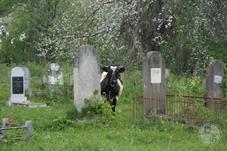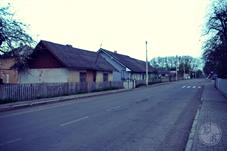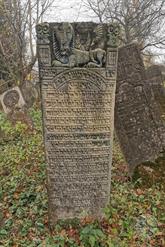Vashkivtsi
Documentary references of Vashkivtsi begin in 1431. In 1433 the village was handed over by the Polish king to the Moldovan state. As part of the Austro-Hungarian Vashkivtsi were in 1775, and from 1918 to 1940 belonged to Romania. In parallel with the present name, until the second half of the 19 century, the name Vaskovtsi was used.
In 1890 there were 790 Jews in Vashkivtsi (16.5%),
in 1930 - 820 Jews (13%),
after 1945 - 5 Jewish families.
In 1890 there were 790 Jews in Vashkivtsi (16.5%),
in 1930 - 820 Jews (13%),
after 1945 - 5 Jewish families.
The Jewish community existed in Vashkivtsi from the middle of the 15th century. There was a synagogue and a cemetery. From the beginning of the 19th century there was a Jewish school and a hospital.
The Jewish population of Vashkivtsi in the 19th century were mostly immigrants from Moldova and Galicia. Most of the local Jews were Hasidim. The main occupations are agriculture and crafts.
The family of the landed squire Freytag (Polish) was the uncrowned ruler of this city. Later their importance waned, and the Jewish families, the Lifsches, Schauers, Hellreichs and Birnbaums leased a large portion of the lands and industries which they owned.
The center of the city, as well as the streets and alleys in that area, were inhabited by Jewish tradesmen and dealers.
Three houses of prayer took care of the religious needs of the Jewish population. The Hassidic movement had many adherents, and the 'Miracle Rabbis' of Wiznitz, which was in the immediate vicinity, as well as those from the villages of Ottynya, Czortkow and others in Galicia, were often in this city as guests.
Even before the beginning of the Herzl epoch, there was a Zionist Club formed, at the helm of which stood Moses Gaster.
There were cultural and singing groups, sports clubs and chess clubs. The Jewish Center was the central institution here.
Until 1940 about 60% of the teachers in Vashkivtsi were Jews.
With the Soviet occupation of North Bukovina, all expressions of Jewish public life came to an end. The Zionist institutions were disbanded, the Zionist movement persecuted, and on July 13 1941, around 150 Jewish citizens were deported to Siberia, where the majority of them died.
Upon the reoccupation by German-Romanian troops in July 1941, the approx. 750 Jewish inhabitants of the town were packed into a ghetto and, in October of the same year, deported to Transnistria, where most of them died.
After 1945 several Jewish families returned to Vashkivtsi.
Today (2016), Jews do not live here.
The Jewish population of Vashkivtsi in the 19th century were mostly immigrants from Moldova and Galicia. Most of the local Jews were Hasidim. The main occupations are agriculture and crafts.
The family of the landed squire Freytag (Polish) was the uncrowned ruler of this city. Later their importance waned, and the Jewish families, the Lifsches, Schauers, Hellreichs and Birnbaums leased a large portion of the lands and industries which they owned.
The center of the city, as well as the streets and alleys in that area, were inhabited by Jewish tradesmen and dealers.
Three houses of prayer took care of the religious needs of the Jewish population. The Hassidic movement had many adherents, and the 'Miracle Rabbis' of Wiznitz, which was in the immediate vicinity, as well as those from the villages of Ottynya, Czortkow and others in Galicia, were often in this city as guests.
Even before the beginning of the Herzl epoch, there was a Zionist Club formed, at the helm of which stood Moses Gaster.
There were cultural and singing groups, sports clubs and chess clubs. The Jewish Center was the central institution here.
Until 1940 about 60% of the teachers in Vashkivtsi were Jews.
With the Soviet occupation of North Bukovina, all expressions of Jewish public life came to an end. The Zionist institutions were disbanded, the Zionist movement persecuted, and on July 13 1941, around 150 Jewish citizens were deported to Siberia, where the majority of them died.
Upon the reoccupation by German-Romanian troops in July 1941, the approx. 750 Jewish inhabitants of the town were packed into a ghetto and, in October of the same year, deported to Transnistria, where most of them died.
After 1945 several Jewish families returned to Vashkivtsi.
Today (2016), Jews do not live here.
Vyzhnytsya district, Chernivtsi region
Sources:
- Russian Jewish encyclopedia. Translated from Russian by Eugene Snaider
- Dr. Ascher Leschem-Lifschitz. Waschkoutz / Geschichte der Juden in der Bukowina (History of the Jews in the Bukowina), vol. II. Edited by Hugo Gold. Tel Aviv: Olamenu, 1962. Translated from German by Jerome Silverbush z”l, JewishGen, Inc
Photo:
- Eugene Shnaider
- Alex Den. Jewish cemetery in the town of Vashkivtsi
- Russian Jewish encyclopedia. Translated from Russian by Eugene Snaider
- Dr. Ascher Leschem-Lifschitz. Waschkoutz / Geschichte der Juden in der Bukowina (History of the Jews in the Bukowina), vol. II. Edited by Hugo Gold. Tel Aviv: Olamenu, 1962. Translated from German by Jerome Silverbush z”l, JewishGen, Inc
Photo:
- Eugene Shnaider
- Alex Den. Jewish cemetery in the town of Vashkivtsi

- Home
- Shtetls
- Vinnytsia region
- Volyn region
- Dnipro region
- Donetsk region
- Zhytomyr region
- Zakarpattia region
- Zaporizhzhia region
- Ivano-Frankivsk region
- Kyiv region
- Kropyvnytskyi region
- Luhansk region
- Lviv region
- Mykolayiv region
- Odessa region
- Poltava region
- Rivne region
- Sumy region
- Ternopil region
- Kharkiv region
- Kherson region
- Khmelnytskyi region
- Chernihiv region
- Chernivtsi region
- Cherkasy region
- Crimea
- Synagogues
- Cemeteries
- Objects & guides
- Old photos
- History
- Contact
Jewish towns of Ukraine
My shtetl
My shtetl
Donate
Jewish towns of Ukraine






























